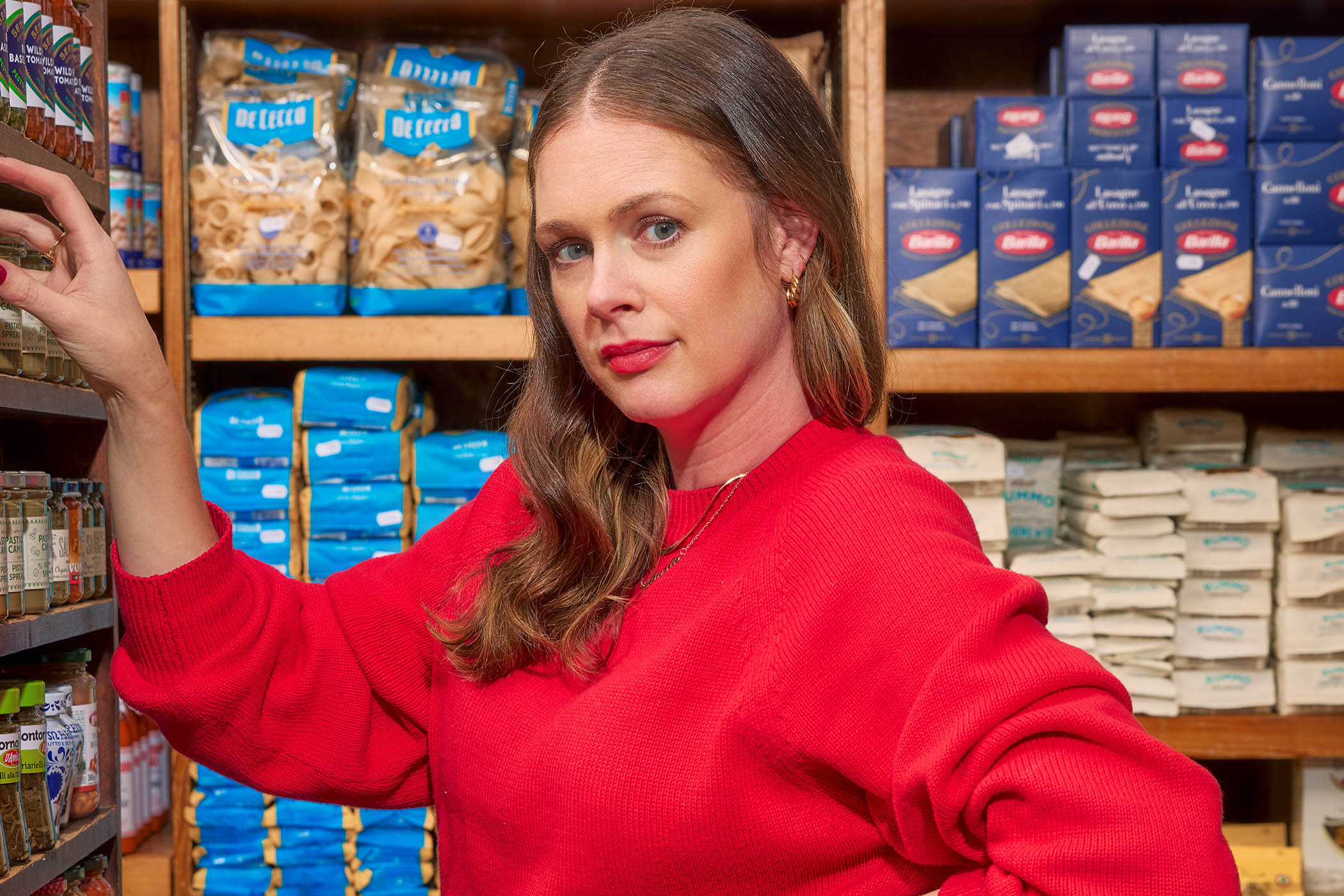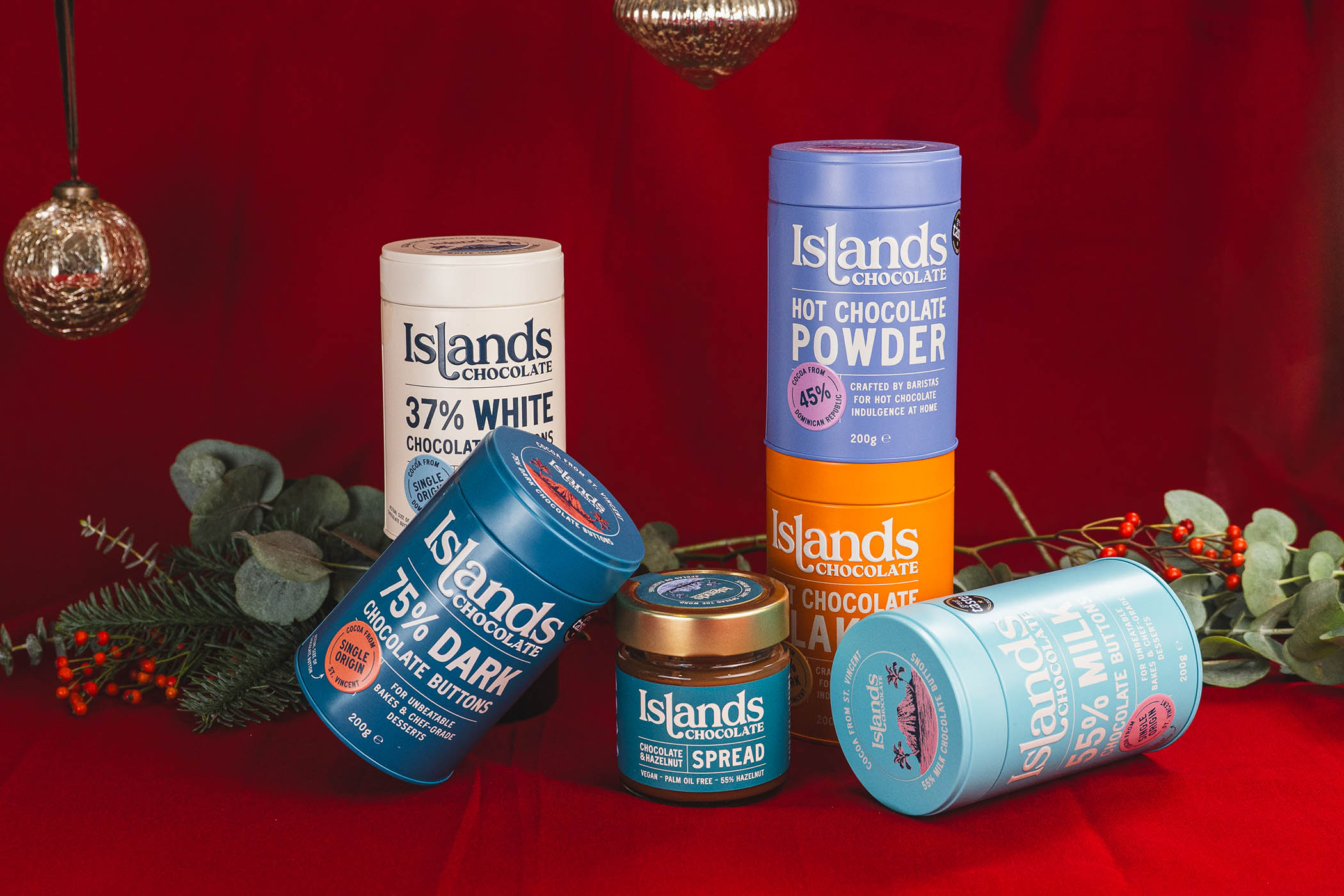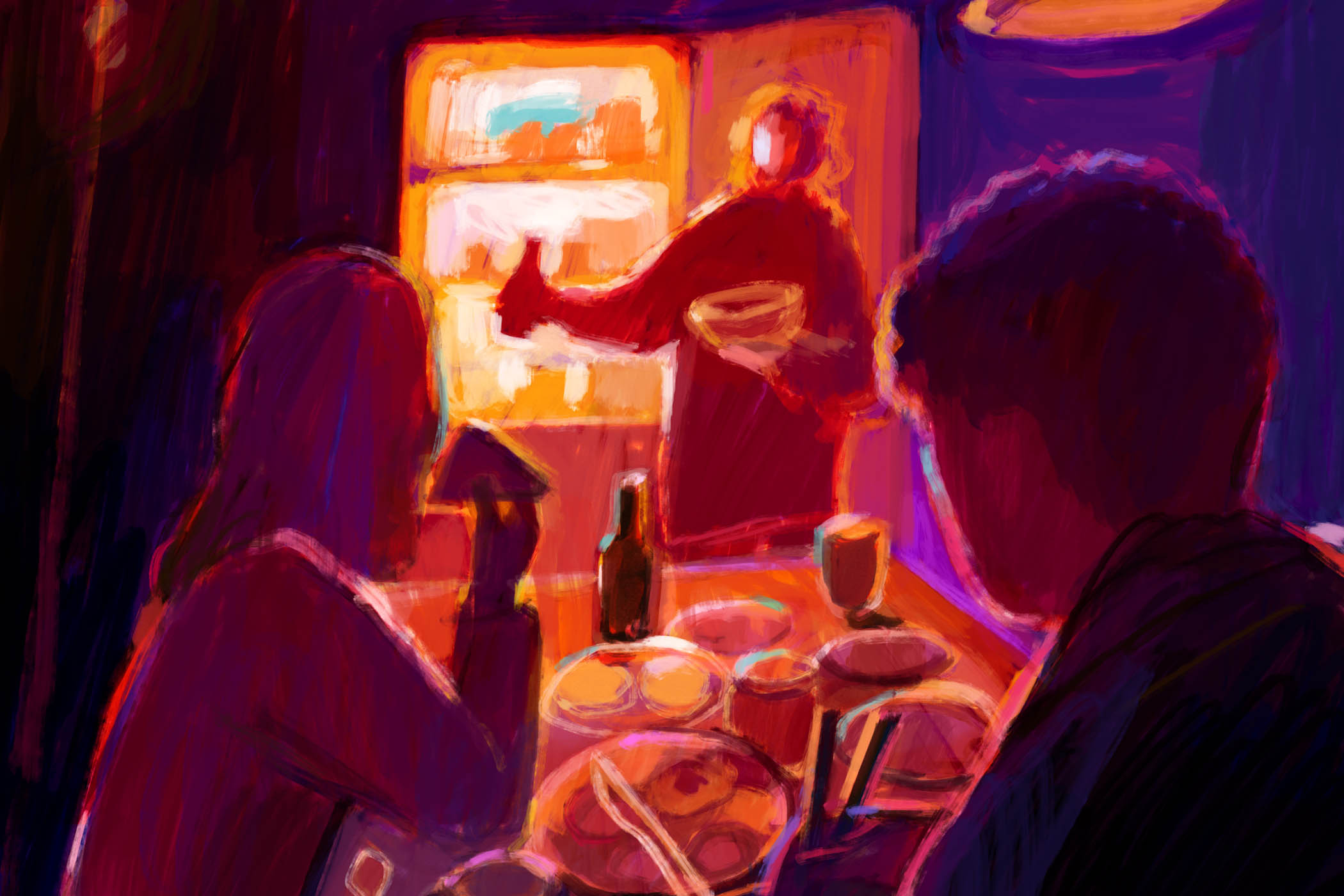Related articles:
Photographs Manuel Vazquez
At the beginning of 2020, the New York Times published a recipe by the chef and food writer Alison Roman titled “Caramelised Shallot Pasta”, alongside an accompanying video. “I care about you,” Roman, then 34, said to camera, wryly. “And I care about me, too. I care about us, you know? I want us to be happy.” Roman was presenting from her aspirationally cramped Brooklyn kitchen, where a drinks trolley, crockery and jars of condiments competed for space. She was wearing a short bob and gold hoop earrings, and she spoke to camera with a winky, welcoming confidence, explaining that she was about to include entire tins of both anchovies and tomato paste in the recipe because – as all home-cooks know – it’s annoying to be left with most of a tin of something having used only a small amount.
The video, which has now been watched more than 1m times, was emblematic of the writer’s offhand style – seven minutes of edited film in which a red-lipped Roman doesn’t so much seduce as flirt goofily with the camera with a kind of adorable nonchalance. She had over-ordered shallots, she said, and used the over-order as an opportunity to develop a dish for a Christmas Eve dinner party she had had with friends. It was a recipe that came about seemingly by chance – perhaps even by accident. And yet it became the New York Times Cooking app’s most popular recipe of the year.
“I have no qualms about telling people how things really are,” Roman says now of the honesty she displayed in the video. She’s sipping a glass of chablis at London’s Quo Vadis restaurant, where we are meeting for lunch. “Or how I’m really feeling. I’d way rather show people the mess.”
To look at Roman now is not to be struck by messiness. Sitting opposite me, she is put together and pristine in a vintage black-leather blazer, fiddling with a gold nameplate necklace as she surveys the menu.
Related articles:
“What’s a cobnut?” she asks, of the fresh hazels native to Britain. When I explain, she admits to never having tried them and, with the enthusiasm she employs in her videos, decides that today is the day to try, on a starter of grilled bread and ricotta, followed by guinea fowl pie and mash. “I have to!”
Roman is in London promoting her fourth cookbook, Something From Nothing – recipes dedicated to the well-stocked pantry and freezer. Her dishes are identifiable both for their big, briny flavours and their charismatic unfussiness. A trained pastry chef, she started working in restaurant kitchens before moving into magazine test kitchens: first at the New York food magazine Bon Appetit, where she became a senior editor, then at Buzzfeed Food, and lastly at the New York Times, where she was made a recipe columnist in 2018. But it was her books and, specifically, her social media feeds, through which she developed a distinctive visual style and charming schtick – funny, relatable, chic – that pushed Roman into the celebrity limelight. Other than perhaps Nigella Lawson, no culinary talent has transcended food quite so successfully as Roman, inspiring as she has so many people not just to embrace beans and to deeply brown their onions, but also to wear crisp button-down shirts and kitsch gold jewellery.

Three months after her shallot pasta recipe was published, the first Covid lockdown struck, and Roman’s “pantry-staple lifestyle” acquired new appeal. The pandemic prevented us from popping out for fresh ingredients, and the lived-in minimalism of Roman’s home became an escape for people who had been forced to remain in their own. But it was during that same period, not long after the recipe had gone viral, that an ill-judged comment in an interview made her infamous. It is an incident she describes now, between mouthfuls of ricotta on toast, as “life-ruining”.
In May 2020, Roman was on a roll. The New York Times had published a string of her recipes to viral acclaim: not just the shallot pasta but also a spiced chickpea stew with coconut and turmeric that was nicknamed #thestew, both of which garnered abundant engagement. (The latter has over 28,000 five-star reviews to date.) Her second cookbook, Nothing Fancy: Unfussy Food for Having People Over, had been published the previous autumn and, somewhat ironically for a book about entertaining (a word that Roman avoids), took off when people were doing the very opposite of “having people over”. I was not alone in having Roman-inspired lockdowns, with nails painted a vermilion hue and many batches of her Tiny Salty Chocolatey Cookies.
That month, Roman completed an interview with the New Consumer and, asked about expanding her personal brand into a commercial venture, described both the organising consultant Marie Kondo and the model-turned-cookbook-author Chrissy Teigen as having “sold out” with their product lines. The article, “What Alison Roman Wants”, was published on a Thursday. By the end of the weekend a few fiercely critical tweets had snowballed into an explosion of outrage across both traditional and social media, pouring scorn on Roman’s perceived hypocrisy – she was herself developing a range of kitchen tools with Material, a start-up cookware brand, at the time – not to mention racial insensitivity (Kondo and Teigen are Japanese and Asian-American respectively). It didn’t help that #thestew, published 18 months prior, had been caught up in conversations about cultural appropriation in cookery, riffing as it did on South Asian curries and Eastern flavours. Within days, Roman had issued an apology on Twitter, but not before the Times put her column on “temporary leave”.
“Why couldn’t I express myself without tearing someone down? I definitely could have, and I’m embarrassed I didn’t,” Roman wrote, adding: “The fact that it didn’t occur to me that I had singled out two Asian women is 100% a function of my privilege… I know that our culture frequently goes after women, especially women of colour, and I’m ashamed to have contributed to that.”
Marie Kondo never responded to the apology. Teigen, who had previously been a supporter of Roman’s, and seemed particularly hurt by her comments, publicly accepted it. Roman has still never met either woman.
When we talk about 2020 today, Roman’s enthusiasm begins to sag – not least, I sense, because those feelings of shame and embarrassment persist. There is also a kind of fatigue. It’s been five years and she’s talked about the incident a lot – perhaps she has run out of new ways to express what is seemingly deep regret. “I took responsibility for it because it was a stupid thing I said,” she says, admitting that she had assumed the world would move on more swiftly, “but that wasn’t what happened.”
I have no qualms about telling people how things really are, or how I’m really feeling
What followed was a period of soul-searching, during which Roman, then single and living in New York, disappeared from public life and leant heavily on her network of close friends. “Anyone who knew me said, ‘I love you and I know who you are,’” she says, with a half-shrug. She believes that things would have played out differently today, that the intensity of the backlash reflected the pervasive anxieties of the time – not least because hers was a case of racial insensitivity that unfolded in the same month that the Black Lives Matter movement rose rapidly.
Did she think that was it for her career? “I mean, yes,” she says. “I thought I had no choice” but to disappear.
It was a spectacular fall from grace. It plummeted Roman from darling of edible hashtags to starkly cancelled in just one weekend. By the end of the year, the New York Times had formally discontinued her column in a manner presented, by both Roman and the paper, as a kind of conscious uncoupling – she “would not be returning”, a release said. She bought a house upstate, in the western Catskills, what she describes now as “never ‘my country home’,” but instead a “weird rectangle house on the corner of a highway” in the small town of Bloomville, New York, which had a defunct pizza restaurant on its ground floor. “It felt like a plan,” she says. “I thought, even if I never work again, I can always run a restaurant out of this place.”
To those who became acquainted with Roman during the pandemic, she may have looked like an overnight success, but she had been quietly and hungrily working in professional kitchens from the age of 19. In 2010, she was working at Quince, a restaurant in San Francisco, and was due to return after a brief spell on the East Coast. But she describes her arrival in New York as like “dropping into a body of water and feeling no resistance”, and so she stayed. She became sous chef at David Chang’s Momofuku Milk Bar, then joined the Bon Appetit test kitchen. (Not long after Roman’s cancellation, Bon Appetit had its own racism scandal – she had long since departed, but for the predominantly white US food industry, 2020 was a year of reckoning.)
I ask what her aspirations were back then. “Small victories,” she says, “that would validate my importance or value.” At first, that meant simply getting her recipes published in Bon Appetit, then to get a cover, write a story, and be involved in strategy. There was no strategy of her own, she says, other than the fact that “I loved cooking, and I wanted to be really good at it.”
Roman was raised in Los Angeles, the only child of parents who split when she was two. Food was important in both of the households she moved between – her father “was the eater,” she says, “like, we’d go here for tacos, there for pastrami – he was into food tourism”, while her mother cooked a lot. She credits the fact that she was often grounded (usually for not making grades) with the evolution of her writing voice. “I wrote my mum a lot of letters to argue why I shouldn’t be grounded,” she says, “And they were good letters – I was good at articulating myself.” Today she is much-praised for the authenticity of her writing voice, for writing like she speaks, and it is this above all around which her community has constellated.
I wrote my mum a lot of letters to argue why I shouldn’t be grounded
“I was immediately struck by how unique her voice was,” Lara Hamilton, founder of Seattle-based cookbook shop, Book Larder, told me recently. She met Roman when she was promoting her first book, Dining In, in 2017. When Roman arrived on the food scene, she immediately inspired a wave of what are known in publishing as “comps” – when new authors are compared to more established ones as a hook for booksellers. “Books by young female authors quickly became ‘for fans of Alison Roman’,” Hamilton went on. “She became a benchmark in the industry very quickly and still holds that space, which is rare. She ushered in a [generation of women food writers] who write in that millennial, conversational voice. Who made cooking cool.”
It goes against the grain in cookbook publishing not to be specific about whether you, say, slice or chop a carrot, “but, I don’t mean to be flippant, it often doesn’t matter,” says Roman, who is, and always has been, unprecious in her instructions and archly relatable. “She has a sort of sharp-edged offhandedness to everything she does,” Helen Rosner, food correspondent of the New Yorker, told me. “A kind of give-no-fucks, seat-of-pants candour that’s tremendously charismatic and attractive.” It is a reassuring tone that says: you can like good food and have it be easy to make – that convenience is not the enemy of good cooking.
That unpreciousness makes her practical appeal internationally nimble; for European cooks, an entire tin or tablespoon of something is infinitely preferable to the US cups system. Roman’s talent lies in her understanding that food is just one aspect of our busy lives. She is our uncomplicating kitchen guide.
Roman’s comeback was a masterclass in how to pivot, and eschewing the norm in favour of new territory has – by accident and, now, by design – become a kind of MO for her. Within six weeks of being dropped by the New York Times she had started self-publishing both a Substack newsletter and a YouTube cooking show, each with names that transcend cooking with quiet confidence: “A Newsletter” and “Home Movies” respectively, where the (many) fans who stuck with her could get more unadulterated Roman: the embracing of imperfection, the sardonic remarks and bleeped-out expletives, the fashion sense where 1970s Americana meets modern minimalism. And then she got a two-book deal.
How has she done it? Partly, it is that messing up and learning from it was always on-brand for Roman – what the New Yorker has described as “studied imperfection”. But she also insists that it was her only option. “If you eat shit on the sidewalk, you have to get up and keep walking,” she says as her pie arrives. In the aftermath of her cancellation, she had no manager and no team, and “I didn’t have a secret stash of money somewhere. I had my skill set, which is cooking and writing, and so I had to just keep cooking and writing.” She did have enough money to buy the property upstate, which wouldn’t have come cheap, though the eccentric building on the corner of a busy road was “all [she] could afford” , she says.
The irony of losing a job I loved was that it was the best thing that ever happened to me
“The newsletter really changed things for me,” she goes on. “The irony of losing a job that I really loved was that, career-wise and financially, it was the best thing that ever happened to me, because I wasn’t beholden to that structure any more. I was like, ‘OK, well now I’m really just gonna be me, and write whatever I want to write.’” Writing about food, she says, is “a kind of emotive connective tissue” for her, and a medium for writing about a host of other things: variously shopping, freezing her eggs, or travelling with a baby. “The more vulnerable you are,” she says, “the more people trust you.”
It was through her community online that Roman, fresh out of a relationship in 2022, met her now-husband, the director Max Cantor. Did he like her recipes? “No! He doesn’t cook!” she says, and goes on to describe how Max’s sister told him she was making an Alison Roman dish for Thanksgiving. “He’s like, ‘Who’s that? I don’t care’.” She mimes showing a phone screen, “And she’s like, ‘this is her’. And he’s like, ‘Oh, I like her’.” In September, he sent her a DM. They married 12 months later. Their son Charlie was born in January of this year.
Nibbling at her pie’s pastry edge, Roman tells me that she didn’t plan to have a baby at the same time as finishing a book, which includes a photo of a bowl of beans balanced on her heavily pregnant belly. Charlie was conceived during a period of recalibration after two unsuccessful rounds of IVF. And she admits that pregnancy challenged her “I can do anything” attitude. “I got my ass kicked: [in the first trimester], I was fully in bed, throwing up all the time – for the first time in my life, I lost my appetite.”
Charlie was born small but healthy one month early and never took to breastfeeding. “It was hard!” she says, “I thought, ‘I feed people for a living, but my son won’t eat from my breast?’ Of course, I internalised it as, ‘Am I a good woman?’” Charlie is a magnificent eater now, she says. The night before we met, I had seen the boy himself at Roman’s London book launch. He had entered the room in his dad’s arms, suckling a dill frond.
By coincidence, most of the dishes in Something From Nothing are things Roman has both craved and felt are achievable for her to make as a new mother, when time and resources are more stretched than ever. The likes of brothy soups and umami-rich stews were “conveniently synced with how I wanted to eat during pregnancy and postpartum – and even now.” She pauses and wonders, “How long are you postpartum for? I think... forever?”
She explains that her mission with the new book has been to make scant resources into exciting meals, which is often how she cooks in the rural Catskills, a far cry from New York – where she can get any ingredient, any time. “Some of my best work has come from doing a fridge clean-out meal, from being given limited pantry ingredients,” she tells me. This approach is a departure from her early books – which featured a “DIY Martini Bar” and a colour-saturated image of Modelo bottles in a bathtub – and reflects how she has grown up along with her readers.
Roman didn’t need to fall back on her plan of opening a restaurant in the Catskills, but she has opened a deli of sorts there, First Bloom, which offers an edit of things she deems essential: good anchovies (of course), European novelties like Haribo and PG Tips, local honey and organic vegetables, and A Very Good Tomato Sauce, a range produced by Roman herself who has, finally, released a product line.
“For years people like me have been like, ‘Why would you buy tomato sauce? Making your own is so easy,” she says, “and I still believe that. But I have also married a person who doesn’t cook. And I also have a baby. I also sometimes don’t want to make my own tomato sauce. It doesn’t mean I can’t, it just means that sometimes I can’t.”
One of the flavours is caramelised shallot and anchovy, a reference to that original recipe which, having never previously featured in one of her books, appears at last in the pages of Something From Nothing – a pantry-staple dish, if ever there was one. She cares about you, you know? She just wants you to be happy.
Buttered tomato soup with lentils and fennel

Imagine, for a moment, a tomato soup that needs no blender to produce an impossibly creamy result; a lentil soup vibrant and gorgeous enough to grace the cover of a cookbook yet humble enough to eat alone at your kitchen counter for a Tuesday lunch. Seasonally agnostic (tinned tomatoes here!), this soup thrives in winter with the best of your pantry staples, as cosy as potato leek soup and made in half the time. Once this soup comes together, you may forget there are lentils in here at all. They magically melt into the pot, nearly disappearing (that’s the idea), giving you creamy texture and luscious body: tomato (and lentil) soup utopia. Serves 4
olive oil 2 tbsp, plus more to serve
unsalted butter 2 tbsp (or more olive oil)
garlic cloves 4, thinly sliced
fennel 1, large bulb, thinly sliced
yellow or red onion 1, medium (or 2 large shallots), thinly sliced
salt and black pepper
fennel seeds 2 tsp
chilli flakes ½ tsp, plus more to taste
red lentils 185g
whole peeled tomatoes 2 x 400g tins
water, or vegetable or chicken stock 1.4 litres
sour cream, full-fat yoghurt, or parmesan cheese to serve
1. Heat the olive oil and butter in a large pot over a medium-high heat. Add the garlic, fennel and onion.
2. Season with salt and pepper and cook, stirring occasionally, until the fennel and onions are completely softened and start to caramelise a bit, 12–15 minutes. (This builds a lot of flavour for your soup – don’t rush it.)
3. Add the fennel seeds and chilli flakes, stirring to encourage contact with the pot so the spices have a chance to toast for a minute or two.
4. Add the lentils, then crush and add the tomatoes, and liquid of your choosing. (I make mine with water, and it’s perfect, but if you have some broth to use, go for it.)
5. Season everything with salt and pepper and bring to a strong simmer. Reduce the heat to medium-low and continue to cook until the lentils have nearly disappeared into the pot, 45-50 minutes. Stir every now and then (especially towards the end of cooking) to encourage the lentils and tomatoes to break down and into one another. If the soup doesn’t feel quite thick enough or the lentils are somehow still not near-mush, increase the heat slightly and continue to cook until it happens. It will happen.
6. To serve, give the soup one more season with salt and pepper. Ladle the soup into bowls and finish with more olive oil, pepper and chilli flakes. I am continually shocked at how good this soup is with nothing else (no squeeze of lemon, no fresh herb in sight), but I do like to spoon a little dollop of sour cream or yoghurt into the bottom of my bowl and top it with the soup. What a treat that is, a little buried puddle of melting sour cream at the bottom of your bowl. A true gift.
• I enjoy the extra texture of thinly sliced fennel and onion here, but if you prefer a more uniformly textured soup, you can finely chop them.
• The soup can be made five days ahead and refrigerated, or three months ahead and frozen.
• Eat with good slices of cheddar cheese on oiled toast or a classic grilled cheese; a few links of nice, spicy sausage; a big, broad-leaf, endive (escarole) salad.
Braised pork stew with cabbage, olives and lemon
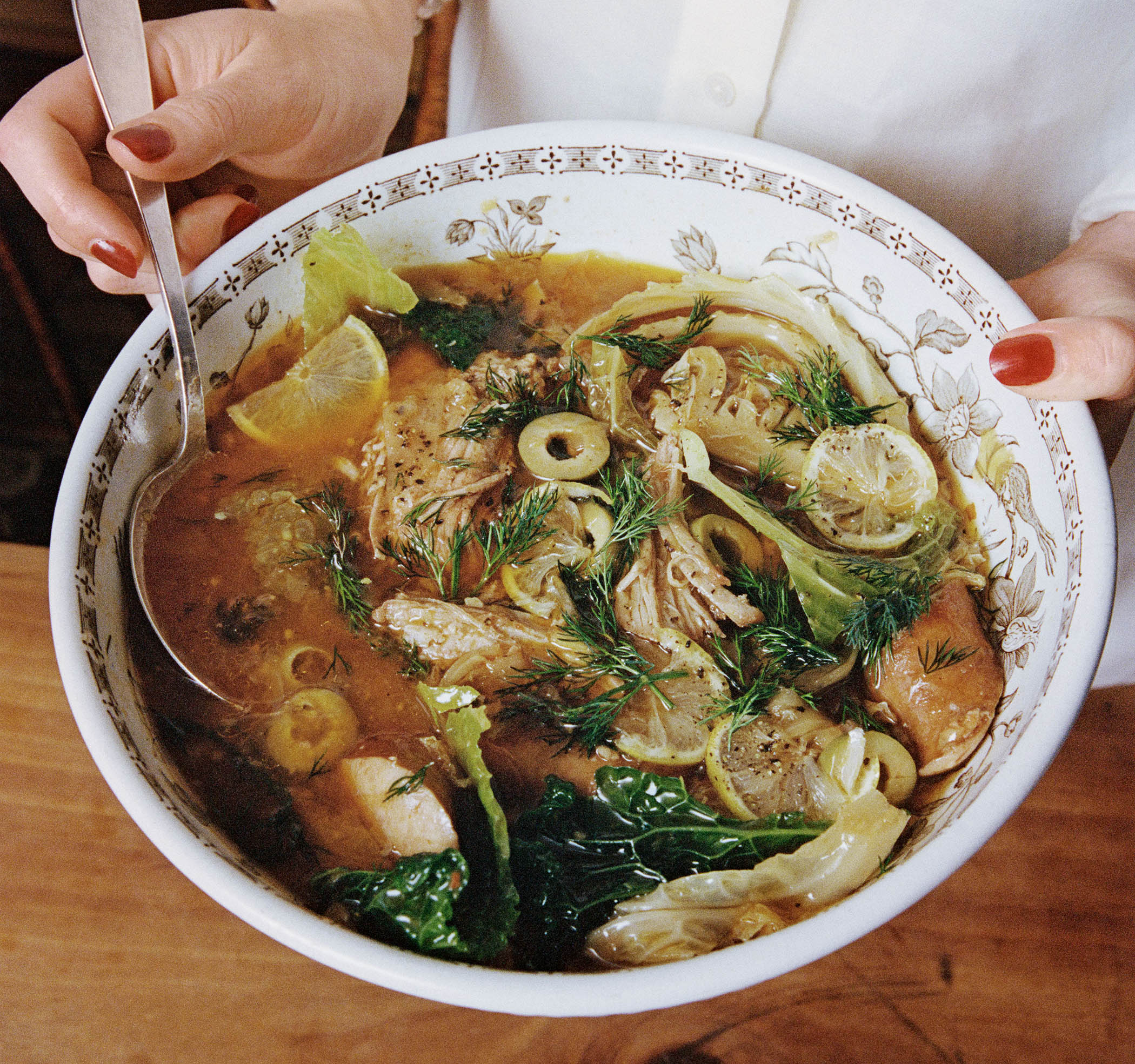
I like to go to the Russian baths as often as I can. Part of the pleasure (and it is all about pleasure) is that in between sweating it out in any number of ways, you also have access to some very, very good Russian and eastern European food: pelmeni, chopped salads with the good feta and lots of wonderful soups, stews and braised meats.
One of my favourites, solyanka (once listed as “pickle soup” and it had sliced hot dogs in it) is something I’ve aspired to and failed to re-create in my own home, but the pursuit did lead me here: a brothy bowl of sour cabbage and fatty smoked pork, studded with fresh lemon and green olives, finished with a fistful of dill. I’m going to call this one supremely elegant (not the usual term used to describe pork stews) – something you might be inspired to serve “for company”, alongside either a dish of slow-cooked potatoes or perhaps nothing at all. Serves 6-8
boneless pork shoulder 1.35kg, cut into 3-5cm pieces
salt and black pepperolive oil 1 tbsp
onion 1, large, thinly sliced
garlic cloves 6, thinly sliced
tomato purée 2 tbsp
smoked or sweet paprika 1 tbsp
chilli flakes 1 tsp, plus more as needed
white distilled vinegar 120ml, plus more as needed
cabbage 1 head, medium or half large (about 570g), chopped or torn into large pieces
kielbasa 225-350g, sliced (not too thin)
pitted mild green olives 150g, thinly sliced
lemon 1, thinly sliced, seeds removed
dill 60g, finely chopped
1. Season the pork with salt and pepper. Heat the oil in a large pot over a medium-high heat. Add the pork – the pot might be a little crowded at first, but the meat will shrink as it cooks. Cook, turning occasionally, until each side is nicely browned, 15-20 minutes.
2. Transfer the pork to a plate or bowl while you build the rest of the stew. (If your pork was especially fatty, you might want to pour off some of the fat from the pot.)
3. With the heat still on medium-high, add the onion and garlic to the pot and season with salt and pepper. Cook until the onions get a bit of colour, 5-8 minutes.
4. Add the tomato purée and cook for a minute or two. Add the paprika and chilli flakes and cook for another minute or two to toast the spices.
5. Add the vinegar, 1.9 litres water, the cabbage and the reserved pork (plus any juices that have accumulated). Season with salt and pepper and bring to a simmer.
6. Reduce the heat until just barely bubbling and simmer gently, uncovered, until the pork is impossibly tender – after 3-3½ hours, it should nearly fall apart when prodded with a fork or knife. At this point, the broth should also taste very good and the cabbage will be translucent and almost melty in texture. If the pork doesn’t quite want to fall apart just yet, be patient and keep simmering.
7. Once the stew is in a good place, add the kielbasa and olives, letting them simmer together for 10-15 minutes. Taste the stew and adjust with salt, pepper and more vinegar if you feel like it needs it.
8. Finally, remove the pot from the heat and add the lemon slices and dill, swirling to evenly distribute.Ladle into bowls and serve.
• This can be made five days ahead, stored in a resealable container and refrigerated, or frozen for up to a month.
• This stew almost wants potatoes simmered in it (which you could do), but it’s also nice served over potatoes any roasted, steamed or boiled potato.
Fruit salad with chives and sticky walnuts
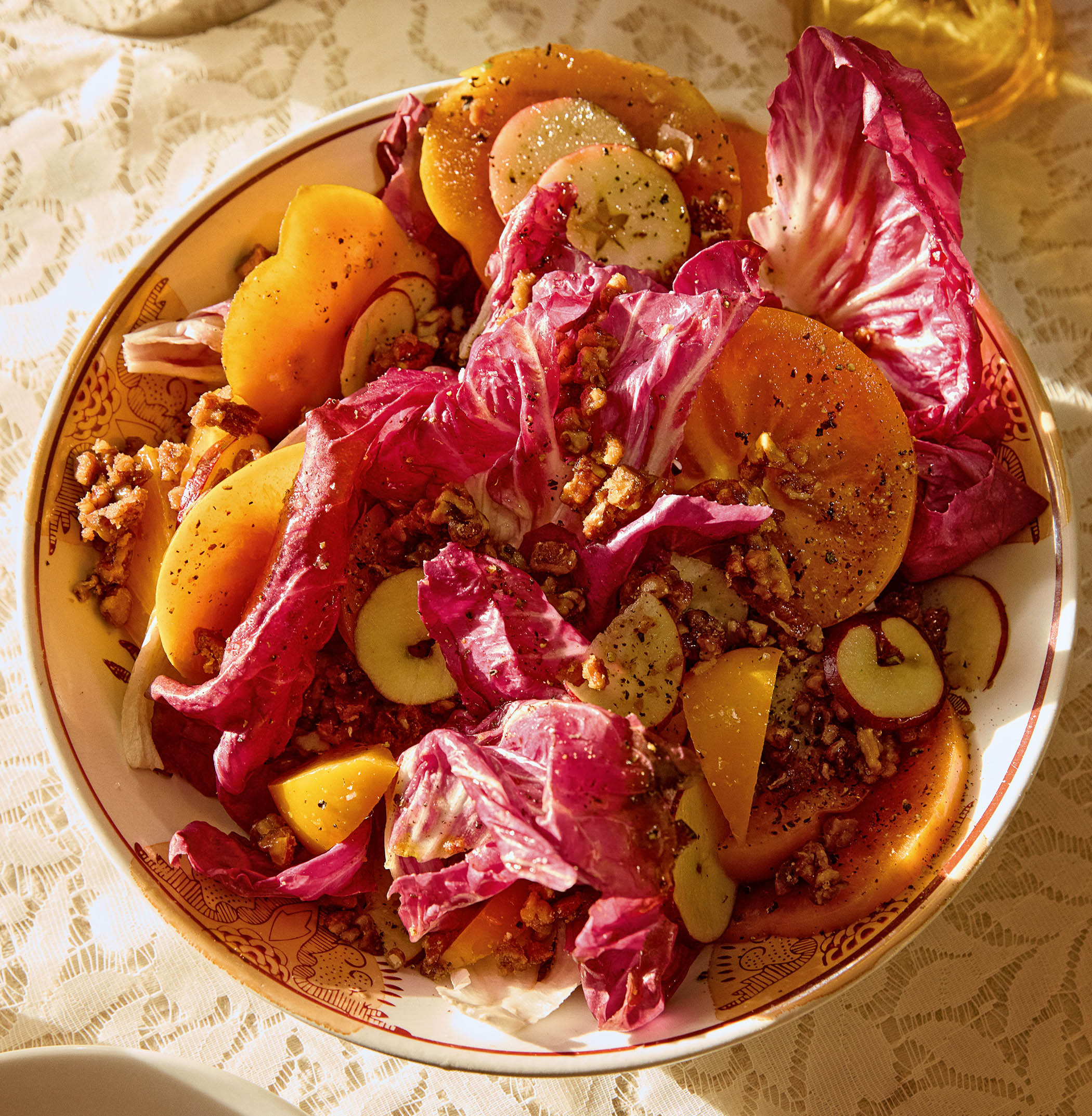
This sort of salad loves to be the centre of attention, served in front of your finest company alongside a show-stoppy main course, like brisket or roast chicken.
The chopped walnuts on this salad, toasted in oil and caramelised in honey, just might be the best thing to ever happen to a slice of fruit or leaf of greenery. They’re sticky and also crunchy, savoury but also sweet. They are, in short, a miracle – and maybe the best reason for making sure your pantry (or freezer) always has a bag of walnuts in it.
I’m calling this a fruit salad because fruit is the lion’s share here, but the savoury, bitter greens (radicchio, chicory, endive) are pulling a lot of weight in making this a salad and not just a pile of fruit and nuts (though I do love a pile of fruit and nuts).
You may be tempted to add a few shavings of cheese – and that would be good – but I promise you, with the nuts and honey, it really doesn’t need it. Serves 4-6
olive oil 2 tbsp, plus more to serve
walnuts or pecans 100g, coarsely chopped
fennel seeds 1 tbsp (optional)
salt and black pepper
honey 2 tbsp
crisp tart apples (such as Honeycrisp or GoldRush) 2, thinly sliced
persimmon or pear 1, thinly sliced
sherry vinegar, apple cider vinegar or fresh lemon juice 2 tbsp, plus more to taste
bitter greens (radicchio, chicory, endive or a peppery green like rocket) 2-3 handfuls
chives 25g, finely chopped
1.
Heat the olive oil and walnuts or pecans in a small skillet over a medium heat. Cook, tossing occasionally, until the nuts begin to toast, about 2 minutes.
2.
Add the fennel seeds (if using) and season with salt and pepper. Continue cooking, stirring often and keeping a close eye so nothing burns, until the nuts are golden brown and well toasted, 4-5 minutes.
3.
Add the honey and give it a stir; it’ll bubble up and start to caramelise a bit around the edges – this is good. Make sure all the nuts are evenly coated, then remove them from the heat and set aside.
4.
In a large bowl, combine the apples and persimmon, toss with the vinegar, and season with salt and pepper. Let sit for a minute or two until the juices start to run.
5.
Add the bitter greens and chives and toss to coat with the dressed fruit and their juices. Taste a leaf or two and season again with more vinegar, salt and pepper if needed. 6. Add a little drizzle of olive oil and give everything a little tousle to coat. Transfer the salad to a serving platter or bowl and top with the sticky walnuts.
•
The walnuts can be made a few days ahead and refrigerated. They’re fine to use right from the fridge.
Something from Nothing by Alison Roman (Quadrille, £27). Order a copy at observershop.co.uk for £22.95. Delivery charges may apply.
With thanks to Salvino's Deli, 47 Brecknock Road, London N7 0BT
